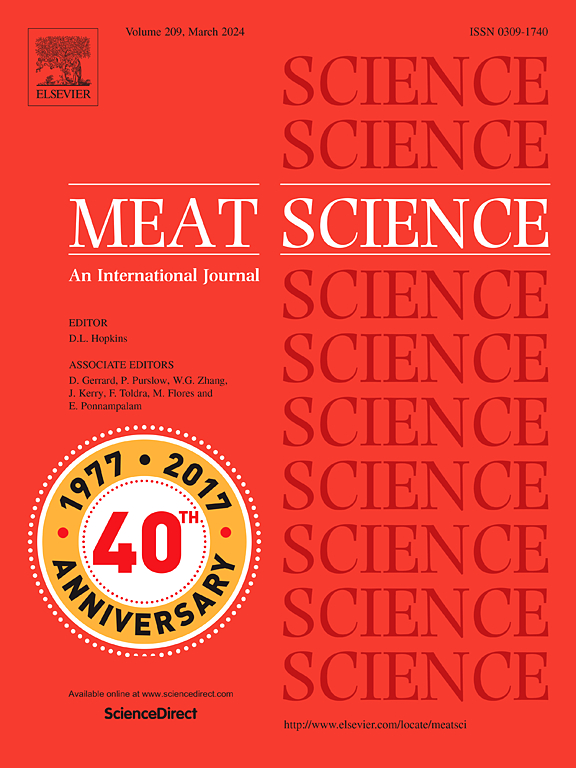Effect of a soy protein isolate/sodium alginate-stabilized diacylglycerol pre-emulsion prepared by ultrasound-assisted homogenization on properties and structure of pork myofibrillar protein composite gel
IF 6.1
1区 农林科学
Q1 Agricultural and Biological Sciences
引用次数: 0
Abstract
This study aimed to examine the rheological behavior, gel properties, and microstructure of composite gels prepared from pork myofibrillar protein (MP) and various diacylglycerol pre-emulsions. The results demonstrated that ultrasonic treatment prior to homogenization of pre-emulsions containing sodium alginate (SA), soy protein isolate (SPI), or both (SPI-SA) significantly enhanced the gel performance when compared to homogenization alone. The MP composite gel containing the ultrasonic SPI-SA pre-emulsion (U-SPI-SA) showed the highest gel strength (21.84 g), water-holding capacity (87.10 %), whiteness (94.20), thermal stability, shorter relaxation times, and reduced cooking loss (22.29 %). This gel also displayed greater hardness, springiness, and gumminess, as supported by the rheological measurements under various test modes. Raman spectroscopy revealed that the MP composite gel with U-SPI-SA pre-emulsion contained more β-sheet and fewer α-helix structures, resulting in a tighter and more uniform network structure and increased moisture proton density. Furthermore, intermolecular force analysis identified hydrogen bonding and disulfide bonding as the dominant interactions in the MP composite gels with different pre-emulsions. These findings support the potential of U-SPI-SA diacylglycerol pre-emulsion to improve the qualities of meat products.
超声均质法制备大豆分离蛋白/海藻酸钠稳定二酰基甘油预乳对猪肉肌原纤维蛋白复合凝胶性能和结构的影响
本研究旨在研究由猪肉肌原纤维蛋白(MP)和各种二酰基甘油预乳剂制备的复合凝胶的流变学行为、凝胶性能和微观结构。结果表明,与单独均质相比,超声处理前含有海藻酸钠(SA)、大豆分离蛋白(SPI)或两者(SPI-SA)的预乳明显提高了凝胶性能。含有超声SPI-SA预乳的MP复合凝胶(U-SPI-SA)表现出最高的凝胶强度(21.84 g)、保水能力(87.10%)、白度(94.20)、热稳定性、较短的松弛时间和降低的蒸煮损失(22.29%)。在各种测试模式下的流变学测量结果表明,该凝胶也显示出更大的硬度、弹性和粘性。拉曼光谱结果表明,U-SPI-SA预乳的MP复合凝胶含有更多的β-片结构和更少的α-螺旋结构,使得网络结构更加紧密均匀,水分质子密度增加。此外,分子间力分析表明,在不同预乳的MP复合凝胶中,氢键和二硫键是主要的相互作用。这些发现支持了U-SPI-SA二酰基甘油预乳在改善肉制品质量方面的潜力。
本文章由计算机程序翻译,如有差异,请以英文原文为准。
求助全文
约1分钟内获得全文
求助全文
来源期刊

Meat Science
工程技术-食品科技
CiteScore
12.60
自引率
9.90%
发文量
282
审稿时长
60 days
期刊介绍:
The aim of Meat Science is to serve as a suitable platform for the dissemination of interdisciplinary and international knowledge on all factors influencing the properties of meat. While the journal primarily focuses on the flesh of mammals, contributions related to poultry will be considered if they enhance the overall understanding of the relationship between muscle nature and meat quality post mortem. Additionally, papers on large birds (e.g., emus, ostriches) as well as wild-captured mammals and crocodiles will be welcomed.
 求助内容:
求助内容: 应助结果提醒方式:
应助结果提醒方式:


